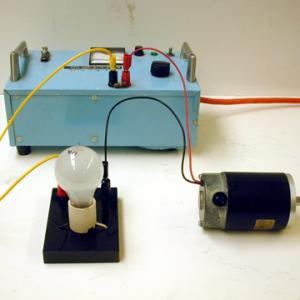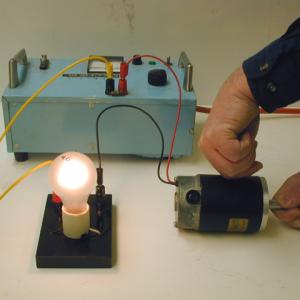College of Liberal Arts & Sciences
5K40.70 - Motor - Back EMF
Hook the motor, power supply, and light bulb in series and turn to 80 Volts. Only when the motor is under load will the light bulb glow. When the motor is running at constant RPM with no load, the light bulb is off as there is not enough current to heat the filament and thus light the bulb. When you apply load to the motor more current is drawn in the circuit and the light bulb will glow.
- Lou Turner, "A Simple Demonstration of Back emf", TPT, Vol. 47, # 8, Nov. 2009, p. 513.
- Robert J. Whitaker, "Motors and Bulbs in Series", TPT, Vol. 47, # 6, Sept. 2009, p. 353.
- "Figuring Physics", TPT, Vol. 41, # 5, p. 303, May 2003.
- Steve Dail, "Overheating Motor Demo", TPT, Vol. 41, # 8, Nov. 2003, p. 444.
- James N. Boyd, "Power and Efficiency", TPT, Vol. 29, # 7, July 1991, p. 457.
- Jack A. Kaeck, "Power Transfer in Physical Systems", TPT, Vol. 28, # 3, March, 1990, p. 214.
- Robert Lehrman, "The Back EMF of a Motor", TPT, Vol. 21, # 5, May 1983, p. 315.
- B- 295, "Back EMF in Motor", DICK and RAE Physics Demo Notebook.
Disclaimer: These demonstrations are provided only for illustrative use by persons affiliated with The University of Iowa and only under the direction of a trained instructor or physicist. The University of Iowa is not responsible for demonstrations performed by those using their own equipment or who choose to use this reference material for their own purpose. The demonstrations included here are within the public domain and can be found in materials contained in libraries, bookstores, and through electronic sources. Performing all or any portion of any of these demonstrations, with or without revisions not depicted here entails inherent risks. These risks include, without limitation, bodily injury (and possibly death), including risks to health that may be temporary or permanent and that may exacerbate a pre-existing medical condition; and property loss or damage. Anyone performing any part of these demonstrations, even with revisions, knowingly and voluntarily assumes all risks associated with them.

